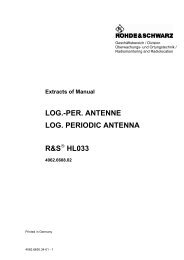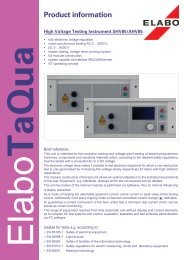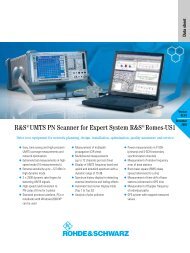Glossary of Video Terms and Acronyms - Isotest
Glossary of Video Terms and Acronyms - Isotest
Glossary of Video Terms and Acronyms - Isotest
Create successful ePaper yourself
Turn your PDF publications into a flip-book with our unique Google optimized e-Paper software.
<strong>Video</strong> <strong>Terms</strong> <strong>and</strong> <strong>Acronyms</strong><br />
<strong>Glossary</strong><br />
CCETT (Centre Commun d’Etudes de Telecommunications et de<br />
Telediffusion, France) – The CCETT is one <strong>of</strong> the three licensors <strong>of</strong> the<br />
MPEG Layer II coding algorithm. The audio coding technique, originally<br />
developed for DAB under EUREKA 147 jointly with IRT <strong>and</strong> Philips, was<br />
selected by ISO/MPEG as Layer II <strong>of</strong> the MPEG-1 st<strong>and</strong>ard.<br />
CCIR (Comite Consultatif Internationale des Radiocommunications) –<br />
International Radio Consultative Committee, an international st<strong>and</strong>ards<br />
committee that has been absorbed by the parent body, the ITU. A permanent<br />
organization within the ITU with the duty to study technical <strong>and</strong> operating<br />
questions relating specifically to radio communications <strong>and</strong> to make<br />
recommendations on them. The CCIR does not prepare regulations; it<br />
draws up recommendations <strong>and</strong> reports, produced by experts from both<br />
public <strong>and</strong> private entities, which provide guidance on the best operational<br />
methods <strong>and</strong> techniques. The CCIR is expected to base its recommendations<br />
upon 150 <strong>and</strong> IEC international st<strong>and</strong>ards, but when no relevant one<br />
exists, the CCIR has been known to initiate st<strong>and</strong>ardization. These recommendations<br />
<strong>and</strong> reports provide a basis for international st<strong>and</strong>ardization <strong>of</strong><br />
telecommunications.<br />
CCIR-468 – Specifies the st<strong>and</strong>ard for weighted <strong>and</strong> unweighted noise<br />
measurements. The weighted st<strong>and</strong>ard specifies the weighting filter <strong>and</strong><br />
quasi-peak detector. The unweighted st<strong>and</strong>ard specifies a 22 Hz to 22 kHz<br />
b<strong>and</strong>width limiting filter <strong>and</strong> RMS detector.<br />
CCIR-500 – Method for the Subjective Assessment <strong>of</strong> the Quality <strong>of</strong><br />
Television Pictures. CCIR-500 is a detailed review <strong>of</strong> the recommendations<br />
for conducting subjective analysis <strong>of</strong> image quality. The problems <strong>of</strong> defining<br />
perceived image quality are reviewed, <strong>and</strong> the evaluation procedures<br />
for interval scaling, ordinal scaling, <strong>and</strong> ratio scaling are described – along<br />
with the applications for which each is best employed.<br />
CCIR-601 – See ITU-R BT.601.<br />
CCIR-656 – The physical parallel <strong>and</strong> serial interconnect scheme for ITU-R<br />
BT.601-2-601. CCIR 656 defines the parallel connector pinouts as well as<br />
the blanking, sync, <strong>and</strong> multiplexing schemes used in both parallel <strong>and</strong><br />
serial interfaces. Reflects definitions in EBU Tech 3267 (for 625 line signals)<br />
<strong>and</strong> in SMPTE 125M (parallel 525) <strong>and</strong> SMPTE 259M (serial 525).<br />
CCIR-6601 – Consultative Committee International Radio. A st<strong>and</strong>ard that<br />
corresponds to the 4:2:2 format.<br />
CCIR-709 – The recommendation considers that the HDTV studio st<strong>and</strong>ard<br />
must be harmonized with those <strong>of</strong> current <strong>and</strong> developing television systems<br />
<strong>and</strong> with those <strong>of</strong> existing motion-picture film. In a review <strong>of</strong> current<br />
systems, a consensus was identified in specifications for opto/electronic<br />
conversion, picture characteristics, picture scanning characteristics, <strong>and</strong><br />
signal format (both analog <strong>and</strong> digital representations). Work is underway in<br />
the editing <strong>of</strong> national <strong>and</strong> CCIR-related documents to determine whether<br />
these consensus values may be affirmed in the next review <strong>of</strong> the individual<br />
documents. The values in Rec 709 are considered interim, <strong>and</strong> CCIR<br />
notes that continuing work is expected to define target parameters for<br />
future improved image rendition.<br />
CCIR-801 – At present, the first results on studies related to Study<br />
Programme 18U/11 have been collected. It must be recognized that these<br />
studies must be intensified in close cooperation with such organizations as<br />
the IEC <strong>and</strong> ISO to take fully into account the requirements for implementa-<br />
26 www.tektronix.com/video_audio<br />
tion <strong>of</strong> HDTV for media other than broadcasting, i.e., cinema, printing,<br />
medical applications, scientific work, <strong>and</strong> video conferencing. In addition,<br />
the transmission <strong>of</strong> HDTV signals via new digital transmission channels or<br />
networks has to be considered <strong>and</strong> taken into account.<br />
CCITT (Comite Consultatif Internationale Telegraphique et<br />
Telephonique) – A committee <strong>of</strong> the International Telecommunications<br />
Union responsible for making technical recommendations about telephone<br />
<strong>and</strong> data communication systems for PTTs <strong>and</strong> suppliers. Plenary sessions<br />
are held every four years to adopt new st<strong>and</strong>ards.<br />
CCITT 0.33 – Recommendation 0.33 <strong>of</strong> the CCITT Specification for<br />
Measuring Equipment, Volume IV, Series O Recommendations-1988. This<br />
defines the automatic test sequences that are used to check on the different<br />
parameters that are important to signal quality. Recommendation 0.33<br />
has defined sequences for both monaural <strong>and</strong> stereo audio testing. Also<br />
called EBU Recommendation R27.<br />
CCK – See Composite Chroma Key.<br />
CCTV – See Closed Circuit TV.<br />
CCU – See Camera Control Unit.<br />
CD – Committee Draft.<br />
CD (Compact Disc) – A 4.75" disc used to store optical, machinereadable,<br />
digital data that can be accessed with a laser-based reader such<br />
as a CD player.<br />
CD-DA (Compact Disc-Digital Audio) – St<strong>and</strong>ard music CDs. CD-DA<br />
became CD-ROMs when people realized that you could store 650 Mb <strong>of</strong><br />
computer data on a 12-cm optical disc. CD-ROM drives are simply another<br />
kind <strong>of</strong> digital storage media for computers, albeit read-only. They are<br />
peripherals just like hard disks <strong>and</strong> floppy drives. (Incidentally, the convention<br />
is that when referring to magnetic media, it is spelled disk. Optical<br />
media like CDs, laserdisc, <strong>and</strong> all the other formats are spelled disc.)<br />
CDDI (Copper Data Distributed Interface) – A high-speed data interface,<br />
like FDDI but using copper. See FDDI.<br />
CD-I – See Compact Disc Interactive.<br />
CD-ROM – See Compact Disc Read Only Memory.<br />
CDTV – See Conventional Definition Television.<br />
CD-XA – CD-XA is a CD-ROM extension being designed to support digital<br />
audio <strong>and</strong> still images. Announced in August 1988 by Micros<strong>of</strong>t, Philips,<br />
<strong>and</strong> Sony, the CD-ROM XA (for Extended Architecture) format incorporates<br />
audio from the CD-I format. It is consistent with ISO 9660, (the volume <strong>and</strong><br />
the structure <strong>of</strong> CD-ROM), is an application extension. CD-XA defines<br />
another way <strong>of</strong> formatting sectors on a CD-ROM, including headers in the<br />
sectors that describe the type (audio, video, data) <strong>and</strong> some additional info<br />
(markers, resolution in case <strong>of</strong> a video or audio sector, file numbers, etc.).<br />
The data written on a CD-XA can still be in ISO9660 file system format <strong>and</strong><br />
therefore be readable by MSCDEX <strong>and</strong> UNIX CD-ROM file system translators.<br />
A CD-I player can also read CD-XA discs even if its file system only<br />
resembles ISO9660 <strong>and</strong> isn’t fully compatible. However, when a disc is<br />
inserted in a CD-I player, the player tries to load an executable application<br />
from the CD-XA, normally some 68000 application in the /CDI directory. Its<br />
name is stored in the disc’s primary volume descriptor. CD-XA bridge discs,





